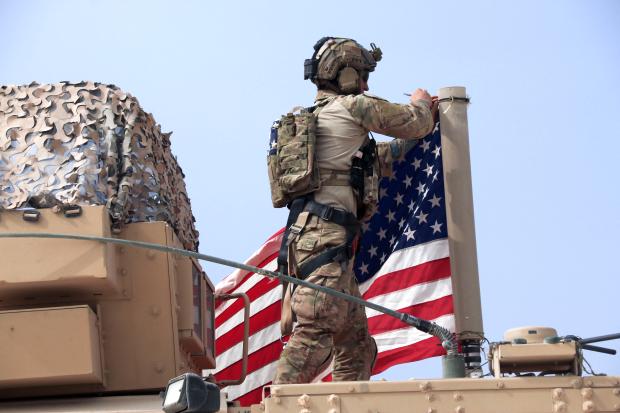
American soldier mounts the U.S. flag on a vehicle near the town of Tel Tamr, north Syria, Sunday, Oct. 20, 2019. Kurdish-led fighters and Turkish-backed forces clashed sporadically Sunday in northeastern Syria amid efforts to work out a Kurdish evacuation from a besieged border town, the first pull-back under the terms of a U.S.-brokered cease-fire. (Photo by Baderkhan Ahmad / AP)
KABUL, Afghanistan — Defense Secretary Mark Esper says he is discussing an option that would keep a small residual U.S. military force in northeast Syria to secure oil fields and continue the fight against Islamic State militants.
Esper said on Monday that he had not made a final decision on that option and has not yet presented it to President Donald Trump.
Speaking at a press conference in Kabul, Esper said that some American forces that are in northeast Syria have not yet started to withdraw. He said they are working with Syrian Kurdish fighters to secure the oil fields in that region so they don’t fall under the control of IS. He said it’s important to make sure IS doesn’t gain revenue from the oil.
Esper said that the troops around Kobani are withdrawing first and that troops in the northeast are still in the towns near the oil.
Esper also said that the U.S. is maintaining combat air patrol over U.S. forces in Syria as the withdrawal goes on. He said the U.S. is using overhead surveillance to try to monitor the recently negotiated cease-fire “as best we can.”
While Trump has insisted he’s bringing home Americans from “endless wars” in the Mideast, Esper said all U.S. troops leaving Syria will go to western Iraq and the American military will continue operations against the Islamic State group.
READ: US troops in Syria going to Iraq, not home as Trump claims
The troops aren’t coming home and the United States isn’t leaving the turbulent Middle East, according to plans outlined by Esper before he arrived in Afghanistan on Sunday. The fight in Syria against IS, once spearheaded by American allied Syrian Kurds who have been cast aside by Trump, will be undertaken by U.S. forces, possibly from neighboring Iraq.
Esper did not rule out the idea that U.S. forces would conduct counterterrorism missions from Iraq into Syria. But he told reporters traveling with him that those details will be worked out over time.
Trump nonetheless tweeted: “USA soldiers are not in combat or ceasefire zones. We have secured the Oil. Bringing soldiers home!”
The Republican president declared this past week that Washington had no stake in defending the Kurdish fighters who died by the thousands as America’s partners fighting in Syria against IS extremists. Turkey conducted a weeklong offensive into northeastern Syria against the Kurdish fighters before a military pause.
“It’s time for us to come home,” Trump said, defending his removal of U.S. troops from that part of Syria and praising his decision to send more troops and military equipment to Saudi Arabia to help the kingdom defend against Iran.
Esper’s earlier comments to reporters traveling with him were the first to specifically lay out where American troops will go as they shift from Syria and what the counter-IS fight could look like. Esper said he has spoken to his Iraqi counterpart about the plan to shift about 1,000 troops from Syria into western Iraq.
Trump’s top aide, asked about the fact that the troops were not coming home as the president claimed they would, said, “Well, they will eventually.”
Acting chief of staff Mick Mulvaney told “Fox News Sunday” that “the quickest way to get them out of danger was to get them into Iraq.”
As Esper left Washington on Saturday, U.S. troops were continuing to pull out of northern Syria after Turkey’s invasion into the border region. Reports of sporadic clashes continued between Turkish-backed fighters and the Syria Kurdish forces despite a five-day cease-fire agreement hammered out Thursday between U.S. and Turkish leaders.
The Turkish military’s death toll has risen to seven soldiers since it launched its offensive on Oct. 9.
Trump ordered the bulk of the approximately 1,000 U.S. troops in Syria to withdraw after Turkish President Recep Tayyip Erdogan made it clear in a phone call that his forces were about to invade Syria to push back Kurdish forces that Turkey considers terrorists.
The pullout largely abandons America’s Kurdish allies who have fought IS alongside U.S. troops for several years. Between 200 and 300 U.S. troops will remain at the southern Syrian outpost of Al-Tanf.
Esper said the troops going into Iraq will have two missions: help defend Iraq and perform a counter-IS mission.
The U.S. has more than 5,000 American forces in Iraq, under an agreement between the two countries. The U.S. pulled its troops out of Iraq in 2011 when combat operations there ended, but they went back in after IS began to take over large swaths of the country in 2014. The number of American forces in Iraq has remained small due to political sensitivities in the country, after years of what some Iraqis consider U.S. occupation during the war that began in 2003.
Esper said he will talk with other allies at a NATO meeting in the coming week to discuss the way ahead for the counter-IS mission.
Asked if U.S. special operations forces will conduct unilateral military operations into Syria to go after IS, Esper said that is an option that will be discussed with allies over time.
On Sunday, U.S. House Speaker Nancy Pelosi led a group of American lawmakers on a visit to Jordan to discuss “the deepening crisis” in Syria.
Jordan’s state news agency said that King Abdullah II, in a meeting with the Americans, stressed the importance of safeguarding Syria’s territorial integrity and guarantees for the “safe and voluntary” return of refugees.
/atm